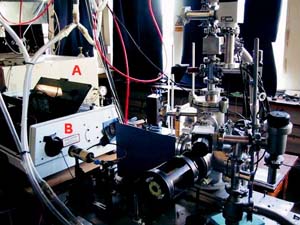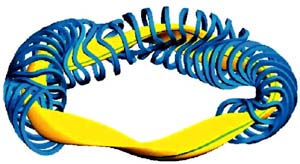| 2004 |

|
YEAR BOOK |
University College Cork
|
Physics research at UCC
|
Optoelectronics and nonlinear optics
Semiconductor laser physics and quantum optics of matter waves. High power and short pulse semiconductor lasers, vertical cavity surface emitting lasers, quantum dot semiconductor lasers, micro-cavity and photonic crystal lasers, nonlinear dynamics of lasers, coherence properties of trapped Bosons and Fermions.
Prof. John McInerney, Dr. Guillaume Huyet
Femtosecond spectroscopy
Femtosecond laser spectroscopy and photochemistry. Fused silica photosensitivity and poling induced by high-intensity UV light. Inscription of fibre Bragg and long-period gratings.
Prof. David Nikogosyan

Electronic structure theory
Condensed matter theory, computational physics, atomic and electronic structure of materials. Carrier transport in semiconductor alloys. Coherent phonon and carrier dynamics in photo-excited materials. Quantum Monte Carlo methods. Randomly driven non-linear dynamical systems.
Prof. Stephen Fahy
Relativity and gravitation
Mathematical Relativity; the initial value problem of general relativity (both constraints and evolution); analytic support for numerical relativity; spherical solutions of the Einstein equations; foundations of General Relativity.
Prof. Niall O'Murchadha

Plasma physics
Computational studies and modelling of experimental data in magnetic confinement fusion research. MHD equilibrium calculations on tokamaks and stellarators. Rapid methods of system identification using statistical methodologies. Diagnostic design studies using simulated databases. Plasma experiments using a double plasma device.
Emission spectroscopy of tokamak plasmas used to study the role of impurities (i) in determining plasma properties, (ii) in the development of the plasma and (iii) in the safe extraction of energy from the plasma. Current Research programmes centre on (i) the investigation of snakes, regions of high density plasma that form through localised impurity accumulation in the plasma and (ii) the use of an injected diagnostic neutral beam to carry out plasma diagnostics through charge exchange spectroscopy.
Dr. Patrick McCarthy, Prof. Michael Mansfield
M�ssbauer spectroscopy
Transmission and backscatter M�ssbauer spectroscopy (a) to investigate magnetism and magnetic domain orientation in iron and iron alloys; (b) to investigate the process of electro deposition by looking at magnetic domain orientation; (c) to investigate structures and bonding in organo-iron complexes and (d) to carry out various other studies of solid-state properties of iron, tin and europium.
Dr. Tony Deeney
Photonic systems
The Photonic Systems Group was created in summer 2003 with Science Foundation Ireland funding to investigate advanced photonic systems. During its first year of operation, the group has been mainly engaged in purchasing equipment and setting up laboratories. A number of state-of-the-art systems testbeds are under construction, to provide research capabilities for a range of topics, including: nonlinear optics for optical signal processing; optical and optoelectronic device physics and their systems applications; optical and quantum communications. The group offers opportunities for post-doctoral research and graduate studentships leading to a Ph.D.
Prof. David Cotter, Dr Andrew Ellis, Dr Bob Manning, Prof. Paul Townsend
Astrophysics
Infrared, optical and X-ray observations of white-dwarf, neutron star and black hole binaries, using ground based (e.g. Keck) and space borne (e.g. Chandra/XMM) observatories.
Dr. Paul Callanan
High-resolution radio studies of Active Galactic Nuclei using Very Long Baseline Interferometry, studies of the compact relativistic jets of AGN, the structure and evolution of their magnetic fields, interactions with the surrounding medium.
Dr. Denise Gabuzda
Laser spectroscopy/Atomic and Molecular physics
Spectroscopy and dynamics of molecular systems in the gas and liquid phase: Ultra sensitive laser- and lamp-based cavity enhanced absorption and cavity ring-down spectroscopy. Atmospheric trace gas detection and gas dynamics. Electronic structure and dynamics of jet-cooled large organic molecules. High resolution luminescence and excitation spectroscopy, Raman spectroscopy of bio-molecules. Nonlinear processes and multi-photon absorption of porphyrins. Laser ablation and synthesis of metal nanoparticles.
Testing and development of atomic models by investigating situations in which the independent particle model may be expected to break down. In particular the 'Giant Resonance' inner shell phenomenon in transition row atoms is investigated through extreme ultraviolet absorption spectroscopy of atoms and ions. The aim is to use Giant Resonance data to interpret and predict changes in properties of these elements with increasing Z and with changes in the atomic environment.
Dr. Andy Ruth, Prof. Michael Mansfield
Physics education
Development of innovative methods of teaching physics at secondary school and university; novel uses of new technologies in science education; applications of computer and hand-held technologies in laboratory teaching.
Prof. Colm O'Sullivan
Geometrical aspects of physics
Investigation of some areas of Physics (supersymmetry, supergravity, supermanifolds) from the mathematical point of view. This is done in close collaboration with the Department of Mathematics (Dr. Donal Hurley).
Dr. Michel Vandyck
Contact: Department of Physics, University College Cork � National University of Ireland Cork;
Tel: (021) 490 2468; Fax: (021) 427 6949;
E-mail: [email protected] ; www.physics.ucc.ie/research.html